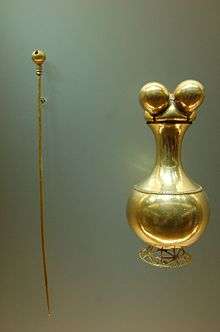Quimbaya civilization
_01.jpg)
The Quimbaya civilization was a South American civilization, noted for spectacular gold work characterized by technical accuracy and detailed designs. The majority of the gold work is made in tumbaga alloy, with 30% copper, which imparts beautiful color tonalities to the pieces. The Quimbaya inhabited the areas corresponding to the modern departments of Quindío, Caldas and Risaralda in Colombia, around the valley of the Cauca River. There is no clear data about when they were initially established; the current best guess is around the 1st century BCE.
The Quimbaya people reached their zenith during the 4th to 7th century CE period known as The Quimbaya Classic. From this period comes the most emblematic piece of this culture: the Poporo Quimbaya (currently exhibited in the Gold Museum). The most frequent designs in the art pieces are anthropomorphic, depicting men and women sitting, with closed eyes and placid expression. There are also many designs of fruits and poporos.
Most of the retrieved items are part of funeral offerings, found in the inside of sarcophagi made of hollow trunks. The gold represented a sacred metal and the passport for the afterlife. Around the 10th century the Quimbaya culture disappeared entirely due to unknown circumstances; studies of the archeological items point to an advanced cultural development and the political structure of a cacicazgo with separated groups dedicated to pottery, religion, trade, gold work and war.
 Quimbaya gold poporo and pestle, at the Gold Museum, Bogotá
Quimbaya gold poporo and pestle, at the Gold Museum, Bogotá Gold necklace from the Quimbaya culture, in the National Museum of Scotland
Gold necklace from the Quimbaya culture, in the National Museum of Scotland
See also
- Indigenous peoples in Colombia
- Calima culture
- Spanish Empire
- Malagana treasure
- Population history of American indigenous peoples
External links
| Wikimedia Commons has media related to Quimbaya. |
- Quimbaya artwork, National Museum of the American Indian
- The Art of Precolumbian Gold: The Jan Mitchell Collection, an exhibition catalog from The Metropolitan Museum of Art (fully available online as PDF), which contains material on Quimbaya civilization